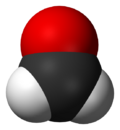Formaldehyde
| Formaldehyde | |
|---|---|

| |
| General | |
| Systematic name | Methanal |
| Other names |
Formalin |
| Molecular formula | CH2O |
| SMILES | C=O |
| Molar mass | 30.02598 g/mol |
| Appearance |
Gas: nearly colorless gas |
| CAS number | 50-00-0 |
| Properties | |
| Density and phase | 815g/mL, gas |
| Solubility in water | 4g/100mL |
| Melting point | -92°C |
| Boiling point | -21°C |
| Structure | |
| Molecular shape | Trigonal planar |
| Dipole moment | 2.33 D |
| Hazards | |
| MSDS | Material safety data sheet |
| Main hazards | Harmful, corrosive |
| NFPA 704 | |
| Flash point | 64 °C |
| Except where noted otherwise, data are given for materials in their standard state (at 25 °C, 100 kPa) Disclaimer and references | |
Formaldehyde is an organic compound composed of Hydrogen, Carbon and Oxygen. In its natural state it is a pungent, foul smelling gas. Some common names for it are: Formalin, Methanal, Methyl aldehyde, Methylene oxide, Morbicid acid, and Oxymethylene. Formaldehyde is a useful chemical in may ways. From the lab to construction sites. Although just like any chemical it is also has some down sides. It is a very harmful if it comes in contact with any part of your body, is inhaled, or is drank. If the right amount is drank it will kill you.[1] All in all, formaldehyde is a very useful chemical, but needs to be handled with care.
Properties
Formaldehyde is made up of three elements: Carbon, Hydrogen, and Oxygen. Formaldehyde is a pungent nearly colorless gas that has a molar mass of 30.02598 g/mol. Formaldehyde’s boiling point is -21°C and its boiling point is -92°C. The molecular formula of Formaldehyde is CH2O and the CAS number is 500-00-0. Formaldehyde is a gas at room temperature. Formaldehyde is soluble in water at 4g/100mL. Formaldehyde is used in a lot of different chemicals. Aldehyde is the most natural form of Formaldehyde, and its systematic name is methanal. Some other names for Formaldehyde are Formalin, Methanal, Methyl aldehyde, Methylene oxide, Morbicid acid, and Oxymethylene.
Occurrences
Formaldehyde is not readily found in nature naturally, it is often made by us humans as byproducts of various processes. Formaldehyde is found in smoke of burning wood, various exhausts of vehicles or manufacturing plants. Formaldehyde is heavily produced and polutes atmospheric layers containing ozone and ozygen ions.[2]
Uses
Formaldehyde is found almost everywhere. It is a combustion product found in cigarette and wood smoke, natural gas, kerosene, exhaust from automobiles, incinerators and power plants. It is also widely used in building materials especially glue, Urea-formaldehyde foam insulation and pressed-wood products such as plywood, particle board, paneling and wood finishes. Many floor coverings contain formaldehyde such as carpet, padding and adhesives. Also used in furniture, paper products, cosmetics, deodorants, shampoos, fabric dyes and permanent-press fabrics, inks, disinfectants, air deodorizers and carpet deodorizers. Mobile homes, motor homes, and travel trailers are known for high amounts of formaldehyde since so many of their components may be made from particle board or pressed-wood products.[3]
Dangers
Formaldehyde is a very toxic substance. If touched, it will could cause sever burns, redness, or blisters. Obviously if you swallow it, some bad stuff is going to happen. It could burn your intestines, liver, throat, mouth, or your stomach causing horrible burning pains. If you drink enough formaldehyde, it is fatal. If formaldehyde gets into your eyes it will cause incredible pain, tearing, or permanent blindness. If formaldehyde is inhaled, it your respiratory system and nose will be damaged. Other effects are dizziness, headaches, chest pains, or complete respiratory failure. The amount of formaldehyde it takes to kill a human is 60-90 mL for the normal person. [4]
References
http://prohousedr.com/formfact.htm
| ||||||||||||||

